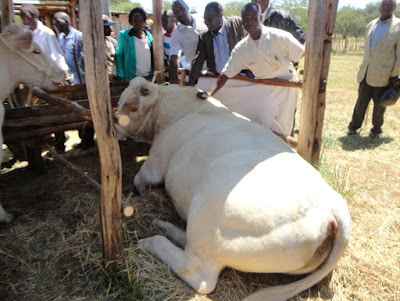By Samwel Nyaga
Safe use of pesticides is
important, as incorrect use can be very hazardous. Speaking during a six days
Conservation Agriculture Training of Trainer (TOT) course held on August 24-29,
2015 at Olympia Hotel in Nyahururu, Mr. Gichuki Hutu, Laikipia West Master
Trainer said that farmers should use the least toxic pesticide available for
pest control.
He said that pesticides
use should be in accordance with registered labels and that it is necessary to
read and apply the information supplied in the label. He noted that target
organisms determine the use of insecticides, fungicides, or herbicides.
The County Government of
Laikipia in collaboration with Food and Agriculture Organization (FAO) of the
United Nations organized the six days course.
He said that pesticides could
enter the body through skin, mouth, and nose when being used. Major risk areas
include: the risk to a person, property and the environment by accidental events
such as spillage or fire; daily chemical exposure at the workplace; and chemical
exposure through spray drift.
He urged farmers to seek
for advice from extension officers on required amount of pesticides, pest
identification, application rates, post-harvest interval, and affected crops.
| Grain being mixed with Actellic super |
Purchase of pesticides should
be at registered agrochemical companies and approved stockists. They should be
in original pack and not in damaged or leaking containers. The labels should be
clear and the quantity should be for only a season.
Farmers should avoid
transporting food, water, animal feed or other reactive hazardous substances
with pesticides. Also, secure hazardous substances to ensure they do not fall
during transportation.
“Use of protective
clothing to cover pesticide entry into the body is important. Selection of
spraying equipment’s is also important and they should not leak,” said Mr.
Hutu.
He said that farmers
should wear protective equipment to prevent skin contact and splashes during
clean up. Separate washing of work and
domestic clothes is equally important.
“Thoroughly clean all
spraying and protective equipment where run-off will not contaminate the
environment or create a hazard. You also
need to wash yourself well,” said Mr. Hutu.
He urged farmers to store
pesticides under lock and key. They should never be stored with foodstuffs or
in living quarters. Ventilation in the store is also important and it should
have fire-fighting equipment. Water and saw dust should always be near the
store.
Simple sprayer calibration
can help to avoid contamination of water or contact on the body while spraying
as it reduces spray drift and enables preparation of enough pesticide for
immediate use only.
Areas that need consideration
during spraying are nozzle position in relation to contact target, time of
spraying and wind or drift. Use of correct filters, pesticide formulation, and
ensuring that water and equipment are clean can prevent nozzle blockage.
Other issues that farmers
need to consider during spraying include: never sucking or blowing blocked
nozzles to clear them; not pouring concentrated pesticides into tanks above
shoulder height; and maintaining nozzles, hoses, regulator gauges and cartridges
for respirators.
Others include: covering
feed and water containers near areas where livestock are grazing; and observing
strict re-entry periods where contact with foliage and skin is unavoidable.
“Follow advice on
disposal of pesticides written on the labels. This is important in ensuring
recommended disposal methods. Rinse empty containers to remove all traces of
pesticide before disposal,” said Mr. Hutu.
Burning or burying away
the containers from water resources are common disposal methods. Ventilated
areas away from people, animals, dwellings, or crops are ideal locations for incinerating
spilt products.
He said that it is
important to take precautionary measures while handling pesticides. The first
aid kit should contain a towel, clean clothing, an approved resuscitation mask
for expired air resuscitation, disposable eyewash bottle and eyewash solution,
soap, nail brush, and clear instructions on what to do with all this equipment.


